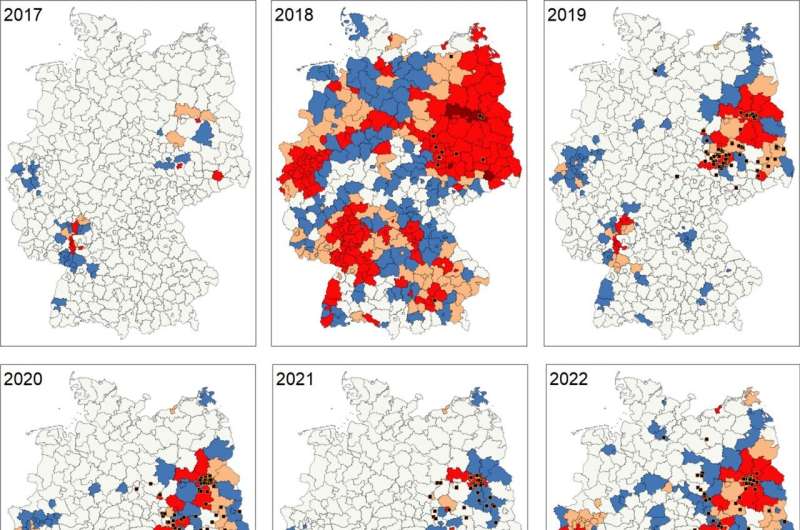This article has been reviewed according to Science X's editorial process and policies. Editors have highlighted the following attributes while ensuring the content's credibility:
fact-checked
trusted source
proofread
Model simulates risk of infection with West Nile virus in Germany

Biogeography researchers at the University of Bayreuth have developed the first model that simulates the spatial and temporal risk of West Nile virus infection in resident birds, migratory birds and humans in Germany. In doing so, they are laying the foundations for a warning system for diseases whose transmission is influenced by climate change. The study is published in the Journal of Epidemiology and Global Health.
West Nile virus (WNV), which can be transmitted to humans by mosquitoes, has long been present in southern Europe. Due to climate change, transmission is also possible in more northern areas. In Germany, cases of the disease in humans were registered for the first time in 2019. A model that maps the risk of infection in Germany can act as a warning system and help to take appropriate preventive measures and adapt medical differential diagnostics.
WNV is a flavivirus and is transmitted by mosquitoes between wild birds. Mosquitoes infected by birds can also transmit the virus to humans. Outbreaks have been occurring in southern Europe in summer for a long time. So far, summer temperatures in Germany have not been warm enough throughout the day and night for transmission by the widespread common mosquito. However, human cases of infection have also been reported in Germany since 2019.
West Nile fever usually heals without complications. However, late effects are common in patients who have developed inflammation of the brain, and people with pre-existing conditions or older people can die due to the West Nile virus penetrating the nervous tissue.
Oliver Chinonso Mbaoma, Dr. Stephanie Thomas and Prof. Dr. Carl Beierkuhnlein from the Department of Biogeography at the University of Bayreuth have developed a model that can be used to simulate the spatial and temporal risk of infection with WNV in Germany.
The model is based on environmental data such as daily temperature and precipitation as well as epidemiological data and was tested using human and animal WNV cases from the last five years. In addition, the research team included characteristics of mosquitoes and bird species that are particularly important for the transmission of WNV in the calculations.
The model results provide a good representation of previous areas with WNV cases and show further areas in the west of North Rhine-Westphalia, the Upper and Middle Rhine and individual districts in Bavaria where transmission would be possible from July to the end of October from a climatic perspective.
"Our results lay the foundation for an early warning system for infectious diseases whose transmission is favored by rising temperatures. The model can help the public health service to take preventive measures. In addition, the medical profession can adapt differential diagnostics based on the risk situation," says Thomas.
More information: Oliver Chinonso Mbaoma et al, Spatiotemporally Explicit Epidemic Model for West Nile Virus Outbreak in Germany: An Inversely Calibrated Approach, Journal of Epidemiology and Global Health (2024). DOI: 10.1007/s44197-024-00254-0



















